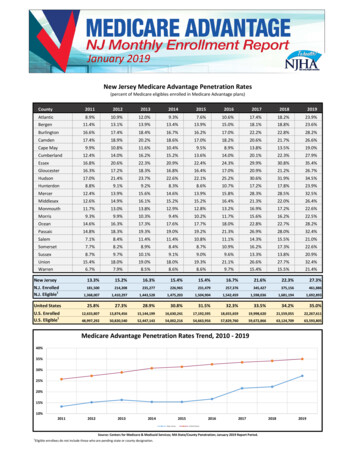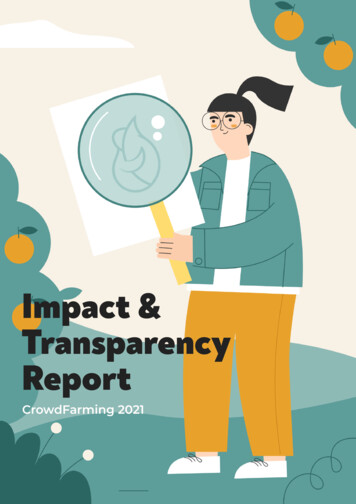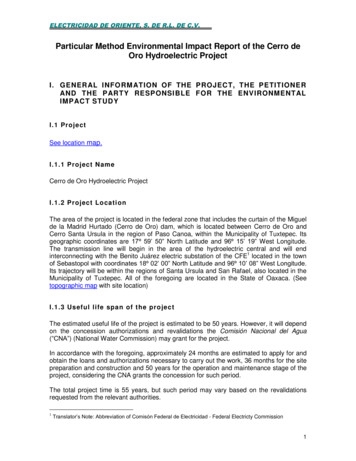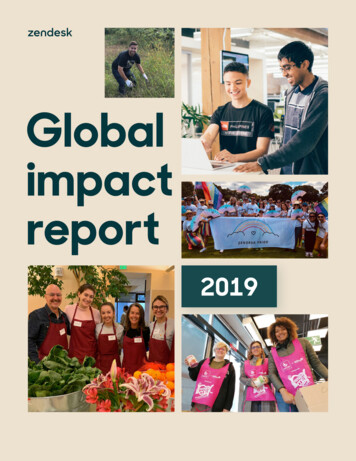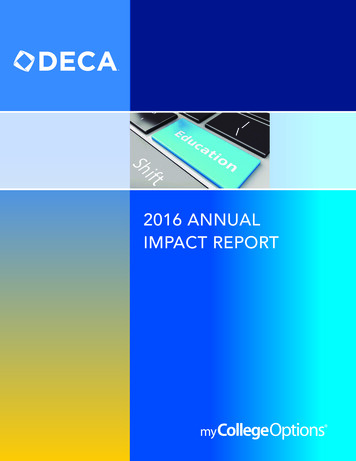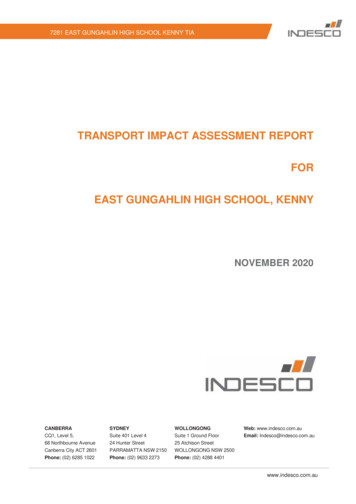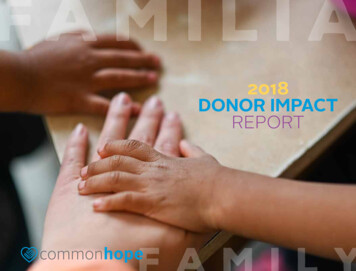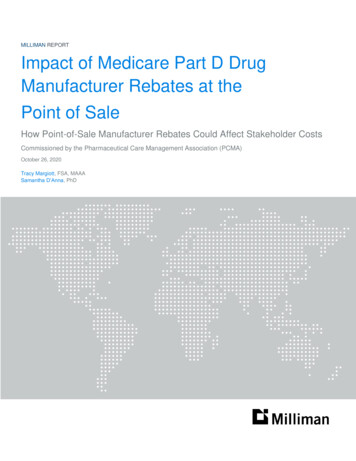
Transcription
MILLIMAN REPORTImpact of Medicare Part D DrugManufacturer Rebates at thePoint of SaleHow Point-of-Sale Manufacturer Rebates Could Affect Stakeholder CostsCommissioned by the Pharmaceutical Care Management Association (PCMA)October 26, 2020Tracy Margiott, FSA, MAAASamantha D’Anna, PhD
MILLIMAN REPORTTable of ContentsEXECUTIVE SUMMARY . 2KEY FINDINGS . 2ESTIMATED FINANCIAL IMPACT. 2STAKEHOLDER IMPACT AND CONSIDERATIONS . 4METHODOLOGY. 8APPENDIX I: SCENARIO DETAIL . 9APPENDIX II: POS REBATE BACKGROUND . 10APPENDIX III: MEDICARE PART D BACKGROUND . 12DISCLOSURES . 14Medicare Part D POS Drug Manufacturer RebatesPCMA1October 2020
MILLIMAN REPORTExecutive SummaryIn May 2018, the Trump Administration released the American Patients First Blueprint to Lower Drug Prices and ReduceOut-of-Pocket Costs, which includes potential changes to the United States healthcare system aimed at “bringing downthe high price of drugs and reducing out-of-pocket costs for the American consumer.”1 One potential change identified inthe Blueprint is “requiring Medicare Part D plans to apply a substantial portion of rebates at the point of sale.” Since then,the Trump Administration, the Centers for Medicare & Medicaid Services (CMS), and the Department of Health and HumanServices (HHS) proposed changes to federal government programs, including Medicare Part D, aimed at addressing thestated goals in the President’s Blueprint. In July of 2020, the Trump Administration issued an executive order on LoweringPrices for Patients by Eliminating Kickbacks to Middlemen, which indicates that HHS shall complete the process to “exclude[ ] retrospective reductions in price that are not applied at the point-of-sale” in Medicare Part D.2 Prior to implementation,the executive order requires HHS to confirm the order is not projected to increase federal spending, beneficiary premiums,or patients’ total out-of-pocket costs.3KEY FINDINGSThe Pharmaceutical Care Management Association (PCMA) requested we estimate the ten-year (2022 to 2031) financialimpact to key stakeholders of potentially reflecting drug manufacturer rebates at the point of sale (POS) in the MedicarePart D market. This is an update to a previously published report estimating the impact of proposed Medicare Part Dprogram changes.4 Most drug manufacturer rebates are currently applied as post-POS price concessions, meaning therebate amounts are paid after drugs have been dispensed.5 Under the proposed scenario, drug manufacturer rebates areinstead used to reduce drug costs at the POS. This change would reduce cost sharing for certain beneficiaries and increase premiums and premium subsidieson average for most beneficiaries. In aggregate, we estimate the cost sharing savings would outweigh thebeneficiary premium increase. This change could increase overall federal government costs by approximately 5% over ten years, primarily dueto an increased risk-adjusted direct subsidy. This change could reduce drug manufacturer coverage gap discount program (CGDP) payments byapproximately 35% over ten years, because fewer beneficiaries would reach the coverage gap phase due to lowerPOS costs and assuming the CGDP would be based on a lower POS cost.It is unclear what terminology would be used to refer to these equivalent POS price concessions. In this report we use“drug manufacturer rebates at POS” to refer to reflecting current post-POS rebates at the POS. We assumed no behavioralchanges among any stakeholders, though we expect stakeholders may change behaviors in some way.ESTIMATED FINANCIAL IMPACTFigure 1 illustrates the estimated cost (savings) from 2022 through 2031 of reflecting manufacturer rebates at the POS.FIGURE 1: ESTIMATED TEN-YEAR (2022-2031) COST (SAVINGS) OF REFLECTING MANUFACTURER REBATES AT POS FORTHE INDIVIDUAL PART D MARKET1, 21BENEFICIARYPREMIUMBENEFICIARY COST FEDERALSHARINGGOVERNMENTDRUGMANUFACTURERCGDPDollar Change (Billions) 28.7( 43.0) 59.5( 45.1)Percent Change16%(12%)5%(35%)Impacts are relative to a baseline scenario in which drug manufacturer rebates are applied after the POS. Appendix I includes baseline values.2The individual Medicare Part D market includes standalone prescription drug plans (PDPs) and Medicare Advantage plans providing drug coverage (MAPDs), and excludes Employer Group Waiver Plans (EGWPs).1The U.S. Department of Health and Human Services (May 2018). American Patients First: The Trump Administration Blueprint to Lower Drug Prices andReduce Out-of-Pocket Costs. Retrieved October 2, 2020, from: tientsFirst.pdf2The White House (July 24, 2020). Executive Order on Lowering Prices for Patients by Eliminating Kickbacks to Middlemen. Retrieved September 23,2020, from: -kickbacks-middlemen3The White House (July 24, 2020). Executive Order on Lowering Prices for Patients by Eliminating Kickbacks to Middlemen, ibid.D’Anna, Samantha and Margiott, Tracy (April 5, 2019). Impact of Potential Medicare Part D Program Changes. Milliman report commissioned by thePharmaceutical Care Management Association (PCMA). Retrieved October 2, 2020, from: /Part-DProgram-Changes FINAL.pdf45In Medicare, drug manufacturer rebates and other price concessions applied after the POS are often referred to as direct and indirect remuneration (DIR).Medicare Part D POS Drug Manufacturer RebatesPCMA2October 2020
MILLIMAN REPORTThe Figure 1 stakeholder cost estimates reflect the following: Beneficiary. The overall beneficiary impact is the sum of the beneficiary premium and cost sharing components.Beneficiary premium excludes the low income premium subsidy (LIPS), and beneficiary cost sharing excludes thelow income cost sharing subsidy (LICS). These are subsidies paid by the federal government for low income (LI)beneficiaries and are included as federal government costs. Federal government. Includes the risk-adjusted direct subsidy, federal reinsurance, LIPS, and LICS. The directsubsidy is a risk-adjusted payment from CMS to plan sponsors to cover the portion of a plan sponsor’s costsrelated to the defined standard benefit. The federal government covers 80% of beneficiaries’ allowed costs in thecatastrophic phase of the Part D benefit through federal reinsurance, reduced for a portion of post- POS priceconcessions that the plan sponsor collects on all drugs. Drug manufacturer CGDP. The drug manufacturer CGDP covers 70% of the cost of brand and biosimilar drugsin the coverage gap phase of the Part D benefit for non-low income (NLI) beneficiaries.Beneficiaries, the federal government, and drug manufacturers through the CGDP are included in Figure 1 because thesestakeholders fund the Medicare Part D program. There are other stakeholders that do not directly fund the program thatmay be affected by potential program changes, including plan sponsors, pharmacy benefit managers (PBMs), wholesalers,pharmacies, and drug manufacturers through items other than the CGDP.We estimate cost sharing may decrease for a subset of beneficiaries, while beneficiary premium and premium subsidiesmay increase for most beneficiaries (premium could increase for some beneficiaries and decrease for others). Theestimates in Figure 1 reflect the overall estimated cost or savings for the entire individual Part D market. The financialimpact for a particular beneficiary may differ from the overall impact shown above. For example, we estimate that reflectingdrug manufacturer rebates at the POS would increase beneficiary premiums and premium subsidies on average. However,this change would decrease cost sharing for certain beneficiaries taking brand drugs subject to rebates. Market wide costsor savings do not imply a majority of beneficiaries would realize that impact. The effects on beneficiaries with differentcharacteristics are described in the next section of this report.The estimates in Figure 1 assume no changes in stakeholder behavior as a result of these potential changes, though weexpect stakeholders could change behaviors in some way. For example, plan sponsors may adjust contracting strategiesand formularies to improve competitive positioning, and beneficiaries may switch to a different plan based on premiumchanges, cost sharing changes, or other factors. The results of this analysis may change if stakeholders or other entitieschange their behavior in response to potential Part D program changes. While our estimates do not reflect behavioralchanges, we comment on potential behavioral changes in the next section of this report. We cannot opine on the likelihoodof any particular change or behavioral response occurring in the future.Our estimates assume changes are implemented for plan year 2022, and that plan sponsors reflect the expected impactof these changes in their June 2021 bid submissions to CMS. Estimates would differ if changes are implemented later than2022, or if plan sponsors do not reflect these changes in their bid submissions.Appendix I provides additional detail on the estimated impact for each cost component for Part D stakeholders.Medicare Part D POS Drug Manufacturer RebatesPCMA3October 2020
MILLIMAN REPORTStakeholder Impact and ConsiderationsMost drug manufacturer rebates are currently applied as post-POS price concessions, meaning the rebate amounts arepaid after drugs have been dispensed. With this change, drug manufacturer rebates are instead used to reduce drug costsat the POS. HHS cites the possible reduction of beneficiary out-of-pocket costs and potential improved formulary coverageof lower list price drugs as support for potentially requiring drug manufacturer rebates to be reflected at the POS.6To estimate the impact of reflecting drug manufacturer rebates at the POS, we modeled replacing drug manufacturerrebates with equivalent POS price concessions on brand drugs. We assumed drug manufacturer rebates apply primarilyto brand (applicable)7 drugs including specialty brands, and did not adjust the cost per script for generics. We assumed nochange to the total dollar amount of rebates.STAKEHOLDER IMPACTIn Medicare Part D, rebates paid after the POS are typically used by plan sponsors to reduce beneficiary premiums andgovernment subsidies (including federal reinsurance, LIPS, and the direct subsidy) as a result of reduced plan liability.While these post-POS rebates are sometimes also used by plan sponsors to enhance benefits, they do not typically directlyreduce a beneficiary’s drug cost at the POS.Unlike post-POS rebates, rebates reflected at the POS would be shared among all stakeholders paying a portion of POSdrug costs. This includes beneficiaries through cost sharing, the federal government through federal reinsurance and theLICS, and drug manufacturers through the CGDP. Any remaining drug costs (plus any non-benefit expenses and profitmargin) are reflected in the plan sponsor’s claim liability and are ultimately funded through the direct subsidy, LIPS, andbeneficiary premium. Beneficiaries. We estimate this change would increase premiums and premium subsidies on average for mostbeneficiaries. It would, however, decrease cost sharing for certain high-cost beneficiaries, and in aggregate, thosecost sharing savings would outweigh the average beneficiary premium increase. The potential cost or savings foreach beneficiary will vary based on an individual’s income, health status, plan choice, pharmacy choice, drug use,and benefit design. For example:-Certain NLI beneficiaries would be impacted by this change, while full subsidy-eligible LI beneficiarieswould see a smaller or no effect because the majority of premium and cost sharing for LI beneficiariesis already subsidized through LIPS and LICS. We project approximately 65% of 2022 individual Part Dbeneficiaries will be NLI.FIGURE 2: PROJECTED 2022 INDIVIDUAL PART D MARKET BENEFICIARY ENROLLMENT BY END-OFYEAR PART D CLAIM PHASE AND INCOME STATUS (AS A % OF TOTAL ENROLLMENT)-NLILITOTAL 0 Claimants5%5%10%Deductible25%9%34%Initial Coverage Limit (ICL)25%11%36%Coverage Gap7%5%12%Catastrophic3%5%8%Total65%35%100%A beneficiary taking no drugs may see an increase in premium without benefitting from lower out-ofpocket cost sharing. We estimate that approximately 10% of beneficiaries will have no claims in 2022(see Figure 2).6HHS (February 6, 2019). Fraud and Abuse; Removal of Safe Harbor Protection for Rebates Involving Prescription Pharmaceuticals and Creation of NewSafe Harbor Protection for Certain Point-of-Sale Reductions in Price on Prescription Pharmaceuticals and Certain Pharmacy Benefit Manager ServiceFees, ibid.7Brand drugs are defined as those applicable to the CGDP.Medicare Part D POS Drug Manufacturer RebatesPCMA4October 2020
MILLIMAN REPORT-We estimate that the beneficiaries most likely to realize reduced overall costs with this change could bethe 10% ( 7% 3%) of beneficiaries we estimate are both NLI and end the year in the coverage gap orcatastrophic (post-ICL) phases (see Figure 2). This is a result of the following combined effects:oBeneficiaries taking drugs subject to coinsurance (as opposed to fixed dollar copays) couldrealize savings with this change, because their cost sharing could be based on a lower POScost. In Part D, drugs in the deductible phase are subject to 100% coinsurance, and drugs inthe catastrophic phase are typically subject to 5% coinsurance. Drugs in the ICL could besubject to either copays or coinsurance, depending on the drug formulary tier and benefitdesign. In the coverage gap, benefit designs may also vary, but most individual Part D planshave 25% coinsurance on brand drugs.oHigher-cost brand and specialty drugs are typically subject to coinsurance. Based on CMS data,many plans offer coinsurance on high cost brand and specialty drug tiers in the ICL phase,while lower-cost generics are typically subject to fixed copays.8 Nearly all brand and specialtytiers are subject to coinsurance in the coverage gap. Beneficiaries taking these higher-costbrand or specialty drugs are more likely to end the year in the coverage gap or catastrophicphases of the Part D benefit, where their reduction in out-of-pocket costs is more likely tooutweigh the increased premium.We estimate that NLI beneficiaries that end the year in the pre-ICL phases would typically have higheroverall costs (premium plus cost sharing) if drug manufacturer rebates were reflected at the POS.However, some of the pre-ICL NLI beneficiaries, as well as partial subsidy LI beneficiaries, may alsorealize reduced overall costs.Beneficiaries taking drugs subject to fixed copays would typically not see a reduction in out-of-pocketcosts with this change. However, it is possible that their cost sharing decreases if the reduced POS costis less than the copay. This is because, in Part D, beneficiaries pay the lesser of the POS drug cost andthe fixed copay amount. This situation would only potentially occur if a drug for which rebates appliedwere subject to a copay; CMS data shows that many brand drugs are subject to coinsurance.-Beneficiaries enrolled in plans with higher aggregate drug manufacturer rebate levels will be moreimpacted than those in plans with lower rebate levels. Typically, nationwide plan sponsors (e.g., largePDPs) can negotiate higher rebate levels than smaller regional plan sponsors. Therefore, NLIbeneficiaries enrolled in plans offered by large nationwide plan sponsors may realize greater out-ofpocket cost reductions with this change, but may also see higher premium increases. As a result, someNLI beneficiaries may migrate to lower-cost plans or MA-PDs if they are sensitive to premium changes. Federal government. We estimate this change could increase overall federal government costs, driven by anincrease in the risk-adjusted direct subsidy, as well as increase in LIPS to a lesser extent. The direct subsidyincreases as plan sponsors cover a greater proportion of claim costs. The higher direct subsidy is partially offsetby a decrease in federal reinsurance as fewer beneficiaries reach the catastrophic phase due to reduced costsharing and because reinsurance is based on lower POS costs. It is also offset to a lesser extent by a decreasein LICS. Drug manufacturer CGDP. This change could reduce drug manufacturer CGDP payments, because the CGDPcould be based on lower POS drug costs and it may take beneficiaries longer to reach the coverage gap phaseof the Part D benefit due to lower POS costs in other benefit phases.KEY CONSIDERATIONS Senior Savings Model. On March 11, 2020, CMS announced the Part D Senior Savings Model (SSM) to offerlower out-of-pocket costs for insulin. The SSM is a voluntary model that will go into effect in 2021. The SSMrestructures how plan sponsors offer supplemental benefits in the coverage gap, by applying the 70% CGDPpayment to the full negotiated drug price instead of the value of the supplemental benefit. This limits the plan8CMS. Medicare Advantage/Part D Contract and Enrollment Data. Benefits Data. Retrieved September 24, 2020, from: olData/Benefits-DataMedicare Part D POS Drug Manufacturer RebatesPCMA5October 2020
MILLIMAN REPORTsponsor’s liability in the coverage gap. To participate in the SSM, plans must offer a maximum 35 copay per 30day supply for a select set of insulins in the deductible, ICL, and coverage gap phases.9It is unclear how POS rebates might affect beneficiaries enrolled in plans participating in the SSM compared tothose that do not participate. Plans that participate in the SSM may expect to enroll a greater share of insulintaking beneficiaries compared to non-participating plans. Insulins typically are associated with relatively high drugmanufacturer rebates which help plan sponsors manage the higher costs of these beneficiaries. Typically,beneficiaries enrolled in plans with higher aggregate drug manufacturer rebate levels could see greater premiumincreases with POS rebates compared to those in plans with lower rebate levels. However, the potential premiumincrease for these plans may be mitigated because plan sponsors retain a greater portion of POS cost reductionswhen beneficiaries pay fixed copays as opposed to coinsurance. Operational complexity. This change could pose operational challenges for plan sponsors, PBMs, and otherparties, which could increase administrative costs. However, it also could potentially reduce plan sponsoradministrative costs for rebate data collection and reporting activities. Rebate transparency. Rebate contracting terms between drug manufacturers and plan sponsors or PBMs areconfidential. This change could make drug manufacturer rebate terms
impact to key stakeholders of potentially reflecting drug manufacturer rebates at the point of sale (POS) in the Medicare Part D market. This is an update to a previously published report estimating the impact of proposed Medicare Part D program changes.4 Most drug manufacturer rebate

